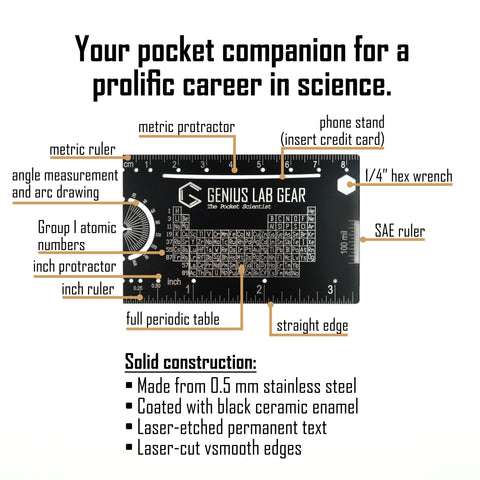Your Cart is Empty
Menu

How to use The Pocket Scientist wallet sized ruler and reference card
3 min read
The Pocket Scientist is an every-day carry tool designed for scientists and engineers. We've packed as many handy tools and references as possible into this little laser-engraved stainless steel card to make your technical work a little easier every day.
If you don't yet have your own, you can order your Pocket Scientist through our store or through Amazon (Prime eligible).


*Please note - the phone stand has been removed on new production. It just didn't work very well!
1. Protractor: Angle measurement and drawing tool
The left front contains a 180 degree arc for measuring and drawing angles. The long lines are every 10 degrees and short lines are every 5 degrees. The straight line cutout denotes 90 degrees and can help to quickly draw right angles.
To draw or measure your own angle:
- Align a starting straight line to the flat edge on the outside of the tool.
- Add a center dot to denote your vertex, in the gap at the center of the arc tool.
- Add a dot at the angle you wish to draw. If measuring, find the angle where the line to be measured intersects.
- Slide away The Pocket Scientist and use the straight edge to connect your dots and complete your angle.
2. Compass: Arc drawing tools (inches and centimeters)
The through holes lines up with major inch and centimeter markings are for drawing arcs and circles of the corresponding radii.
To draw a 6 centimeter radius 60 degree arc:
- Create a vertex, 0 degree and 60 degree dots using the angle drawing tool described above
- Line up the half-hole at 0 cm to your vertex dot and the 6 cm hole to your 0 degree angle dot.
- Using two pencils (or one pencil and a sharp narrow object), put one in each hold and with a slight inward pressure drag the 6 cm hole in the desired direction until it covers approximately 60 degrees. Keeping slight inward pressure ensures the arc does not come out jagged.
- Use the straight edge to connect your vertex and 60 degree dots, then extend the line out until it intersects your new arc. Simply put a dot at the intersection if you don’t want the connecting line.
- Erase any arc past the intersection point.
To draw an arc with a 0.5 cm, 0.5 inch, 0.25 inch or 0.125 inch increment:
- Repeat step 1 above.
- Instead of using the edge half-hole, start your vertex at the sub-integer hole and count forward to the desired radius, remembering to subtract the distance from the edge to the hole of your vertex.
- Repeat steps 3-4 above.
4. Periodic table
The Pocket Scientist contains a full periodic table. The Lanthanide and Actinide series’ are at the bottom and a double-thick vertical line denotes where they are inserted in the upper periods. The left side contains a quick reference atomic number for the Group I elements. For Group and Period, simply count from one left-to-right and top-to-bottom respectively.
5. Ruler
The centimeter side is marked to each 1, 5 and 10 mm while the inches side is marked down to the 1/32nd inch where each smaller unit has a shorter mark line. Note that the origin (zero) side starts flat (flush) to the edge of the tool. This allows you to easily measure the height or depth of an object on a flat surface. For the highest precision on paper, start your line at the “1” marking instead of the edge. For machinists, we’ve also included a small mils ruler on the right edge. Each long line is 100 mil apart, while the shortest lines are 10 mil apart.
7. Quarter inch hex bolt hole
The top right of the card has a small hexagon which will help loosen a quarter inch hex bolt and doubles as a place to clip a carabiner or keychain.
8. QR Code for bonus content
Scan the QR code with your phone each calendar month to view a private page just for card holders. Each month, we’ll replace the page with new content such as fun science nuggets, science jokes, new resources we’ve found or created, news or upcoming events and discounts on new product launches just for card holders! Our goal is to bring you value, fun and happiness with every scan.

Want to find more cool tools for paleontologists? Visit our top-ranked "Gifts for Scientists" shopping list which includes products from all over the internet.
Leave a comment
Comments will be approved before showing up.
Also in Lab Hacks-Helpful Tips for Researchers

The Easiest Way to Draw a Cyclohexane Chair Conformation and Ring Flip
4 min read
Drawing the cyclohexane chair conformations adds unnecessary stress to most chemistry students. Follow the steps below to easily draw the chair conformation and ring flips like a pro so you can focus your mental energy on solving the reaction itself.
Format chemical equations instantly with ChemFormatter
1 min read
Use this totally free and handy Microsoft Word plugin called ChemFormatter to instantly format your chemical equations!
Gifts Lists by Major
Stay up to date
Drop your email to receive new product launches, subscriber-only discounts and helpful new STEM resources.
